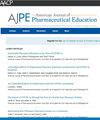教学和评估人口健康与福利的最佳做法。
IF 3.8
4区 教育学
Q1 EDUCATION, SCIENTIFIC DISCIPLINES
引用次数: 0
摘要
目的:阐述药学教育背景下的人口健康与健康的概念、课程整合和评估方法。结果:与公共卫生不同,人口健康和保健的定义强调环境、生物和社会因素在决定人口健康结果中的重要性。各种人口保健措施,包括客观(死亡率、预期寿命)和主观(自我评价的健康状况、生活质量)指标,可用于教学和评估基于人口的保健。课程框架和方法,如临床预防和人口健康课程框架和能力图方法,可用于将人口健康概念融入药学教育。教育工作者可以利用教学和体验式学习机会、技能评估(例如,免疫接种、护理点检测、研究项目)和课外活动(例如,健康博览会、学生开办的诊所)来评估学生与人口健康有关的知识和技能。摘要:虽然认识到人口健康和保健对药剂师的重要性,但在药学教育中缺乏建立的,全面的课程方法来有效地教授这些概念。技能评估有标准化的标准,应该被所有药学教育工作者使用。还存在其他活动和评估,以评估学生的研究项目、服务学习机会、健康博览会和学生开办的诊所。有必要在药学项目和卫生专业教育计划之间进行更大的合作,以发布更多的例子和评估工具,以了解教育者如何确保所有毕业生获得必要的人口健康能力。本文章由计算机程序翻译,如有差异,请以英文原文为准。
Best Practices for Teaching and Assessing Population Health and Wellness
Objective
We aimed to describe the concept of population health and wellness in the context of pharmacy education, curricular integration, and assessment.
Findings
The definition of population health and wellness, which differs from that of public health, emphasizes the importance of environmental, biological, and social factors in determining population health outcomes. Various population health measures, including objective (mortality rates and life expectancy) and subjective (self-rated health and quality of life) indicators, can be used to teach and assess population-based care. Curricular frameworks and approaches such as the Clinical Prevention and Population Health Curriculum Framework and the competency map approach can be used to integrate population health concepts into pharmacy education. Didactic and experiential learning opportunities, skill assessments (eg, immunizations, point-of-care testing, and research projects), and co-curricular activities (eg, health fairs and student-run clinics) can be used by educators to assess student’s knowledge and skills related to population health.
Summary
Despite the significance of population health and wellness for pharmacists, there is a lack of established comprehensive curricular approaches to effectively teach these concepts in pharmacy education. Skill assessments have standardized rubrics and should be used by all pharmacy educators. Other activities and assessments exist to evaluate students in research projects, service-learning opportunities, health fairs, and student-run clinics. There is a need for greater collaboration across pharmacy programs and health profession education initiatives to publish more examples and assessment tools to ensure that all graduates attain the necessary population health competencies.
求助全文
通过发布文献求助,成功后即可免费获取论文全文。
去求助
来源期刊
CiteScore
4.30
自引率
15.20%
发文量
114
期刊介绍:
The Journal accepts unsolicited manuscripts that have not been published and are not under consideration for publication elsewhere. The Journal only considers material related to pharmaceutical education for publication. Authors must prepare manuscripts to conform to the Journal style (Author Instructions). All manuscripts are subject to peer review and approval by the editor prior to acceptance for publication. Reviewers are assigned by the editor with the advice of the editorial board as needed. Manuscripts are submitted and processed online (Submit a Manuscript) using Editorial Manager, an online manuscript tracking system that facilitates communication between the editorial office, editor, associate editors, reviewers, and authors.
After a manuscript is accepted, it is scheduled for publication in an upcoming issue of the Journal. All manuscripts are formatted and copyedited, and returned to the author for review and approval of the changes. Approximately 2 weeks prior to publication, the author receives an electronic proof of the article for final review and approval. Authors are not assessed page charges for publication.

 求助内容:
求助内容: 应助结果提醒方式:
应助结果提醒方式:


